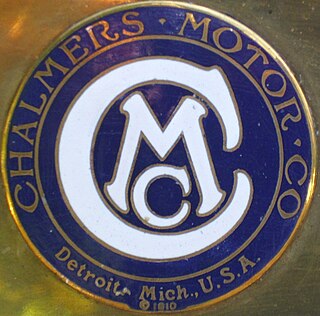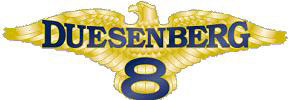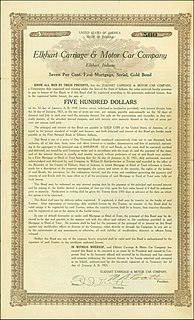Related Research Articles

American Motors Corporation was an American automobile manufacturing company formed by the merger of Nash-Kelvinator Corporation and Hudson Motor Car Company on May 1, 1954. At the time, it was the largest corporate merger in U.S. history.

Rambler is an automobile brand name that was first used by the Thomas B. Jeffery Company between 1900 and 1914.

Chalmers Motor Company was an American car company headquartered in Detroit, Michigan. The company started in 1908 and continued producing high-end vehicles until 1923, when it merged with Maxwell forming the basis for the Chrysler Corporation.

Nash Motors Company was an American automobile manufacturer based in Kenosha, Wisconsin from 1916 to 1937. From 1937 to 1954, Nash Motors was the automotive division of the Nash-Kelvinator Corporation. Nash production continued from 1954 to 1957 after the creation of American Motors Corporation.

Louis-Joseph Chevrolet was a Swiss-American race car driver, mechanic and entrepreneur who co-founded the Chevrolet Motor Car Company in 1911.

The Hudson Motor Car Company made Hudson and other branded automobiles in Detroit, Michigan, U.S., from 1909 until 1954. In 1954, Hudson merged with Nash-Kelvinator to form American Motors Corporation (AMC). The Hudson name was continued through the 1957 model year, after which it was discontinued.

The Brass Era is an American term for the early period of automotive manufacturing, named for the prominent brass fittings used during this time for such things as lights and radiators. It is generally considered to encompass 1896 through 1915, a time when these vehicles were often referred to as horseless carriages.

The Ajax was an American automobile brand manufactured by the Nash Motors Company of Kenosha, Wisconsin, in 1925 and 1926. The Ajax was produced in the newly acquired Mitchell Motors Company plant in Racine, Wisconsin. In 1926, all Ajax models were converted into Nash Light Sixes.

Duesenberg Automobile and Motors Company, Inc. was an American racing and luxury automobile manufacturer founded in Indianapolis, Indiana by brothers Frederick and August Duesenberg in 1920. The company is known for popularizing the straight-eight engine and four-wheel hydraulic brakes. A Duesenberg car was the first American car to win the 1921 French Grand Prix and Duesenbergs won the Indianapolis 500 in 1924, 1925, and 1927. Transportation executive Errett Lobban Cord acquired the Duesenberg corporation in 1926. The company was sold and dissolved in 1937.

The Hudson Hornet is a full-sized automobile that was manufactured by Hudson Motor Car Company of Detroit, Michigan from 1951 until 1954, when Nash-Kelvinator and Hudson merged to form American Motors Corporation (AMC). Hudson automobiles continued to be marketed under the Hudson brand name through the 1957 model year.

The Elcar was an American automobile manufactured from 1915 until 1931. The car was produced by the Elkhart Carriage Company, owned by William and George Pratt, of Elkhart, Indiana, which had been in business for over 30 years before producing its first car.
Detroit Auto Vehicle Company was a short-lived early automobile manufacturer established in the summer of 1904 with a capital stock of US$150,000. Based in Detroit in the old Detroit Novelty Machine Company building, it also had a foundry in Romeo, Michigan. It ceased operation in October 1907 following bankruptcy.
The Sun automobile was made in Elkhart, Indiana from 1916 to 1917, and in Toledo, Ohio from 1921 to 1922.
The Little were two automobiles built in Flint, Michigan, from 1912 – 15 and the company, Little Motor Car Company, founded by William H. Little and William C. Durant that built them. It was incorporated into the current Chevrolet Motor Company.

Scripps-Booth was a United States automobile company based in Detroit, Michigan. Established by James Scripps Booth in 1913, Scripps-Booth produced motor vehicles and was later acquired by General Motors, becoming a division of it, until the brand was discontinued in 1923.

Black Crow automobiles were manufactured from 1909 until 1911 by the Crow Motor Car Company in Elkhart, Indiana, and sold by the Black Motor Company.

The Black was a brass era United States automobile, built at 124 East Ohio Street, Chicago, Illinois, in 1906.

The Crow-Elkhart was an American automobile manufactured from 1909 until 1924 by the Crow-Elkhart Motor Company of Elkhart, Indiana, founded by Martin E. Crow. The company manufactured both four and six cylinder models. After World War I, Crow-Elkhart used Gray victory engines in some of its cars.
Niagara Automobile Company was an American automobile manufacturer.
References
- ↑ Young, Jan (September 2009). Studebaker and the Railroads - Volume 1. ISBN 978-0-557-09291-8 . Retrieved 1 November 2020.
Sterling also made a car called the Komet in 1911
- 1 2 Kimes, Beverly Rae; Clark Jr., Henry Austin (1996). Standard Catalog of American Cars 1805-1942 (3rd ed.). Krause Publications. ISBN 978-0-87341-428-9.